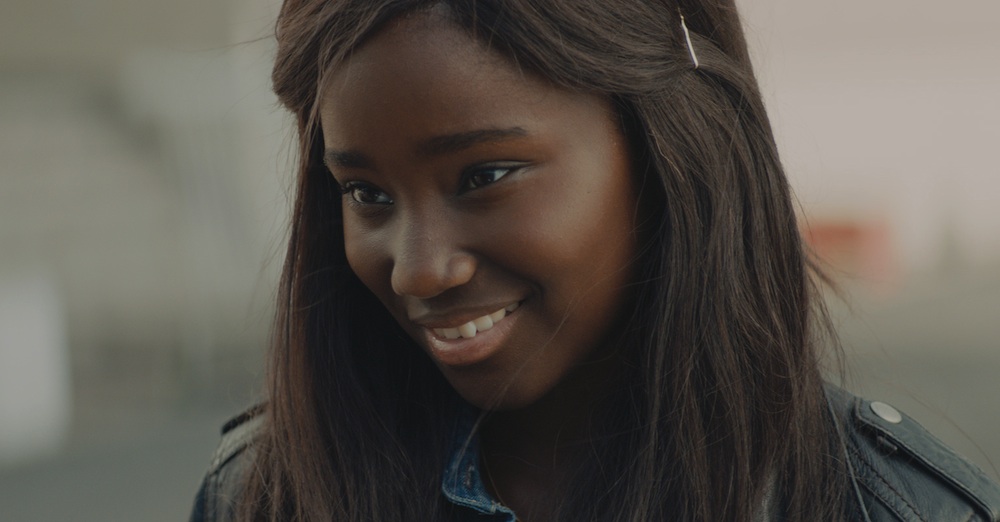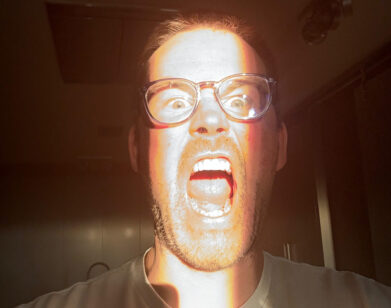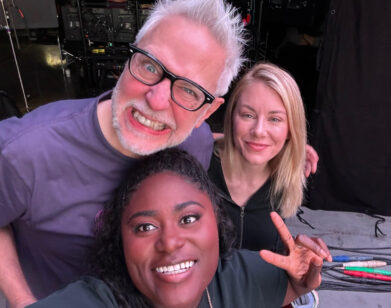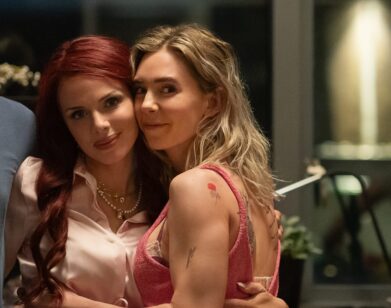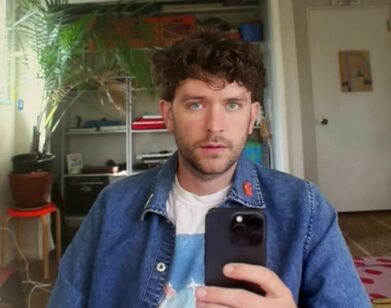Céline Sciamma’s Portrait of a Girl
Since it premiered at Cannes last year, Céline Sciamma’s Girlhood has received a lot of critical attention for displacing the normatively white, adult, male subject of film. Adults, boys, and white people scarcely show up on screen in the film’s two-hour runtime as Sciamma follows her protagonist, Vic (played by Karidja Touré), through her teens in the mostly black and working-class suburbs of Paris. When they do appear, they do so inconsequentially and quietly. Her mother appears in the kitchen for less than a minute; a boy undresses next to her in bed one night, in silence; a white retail worker briefly trails her as she shops for t-shirts at Les Halles.
The triumph of Girlhood, though, is how inconspicuous all of these absences and silences are, and how complete and engrossing a universe Sciamma builds around Vic and her three best friends, the close-knit group who give the film its French title, Bande de filles (or Girl Gang). That is not to say that their youth, their blackness, and their girlhood are inconspicuous in Sciamma’s story, too—because the opposite is true—but none of those things are defined by a deficit of maturity, of whiteness, or of masculinity. In the blue-lit hotel room where they sing along gloriously and hilariously to Rihanna’s “Diamonds,” or on the concrete of an otherwise empty skate park where they idly gossip, their world is full and self-determined and morally complicated. It is not pitiable and quaint or scandalously gritty, and Sciamma’s gaze on it is moody and visually beautiful without being sentimentalist or voyeuristic. As Vic, Touré is entrancing.
Comparisons to Richard Linklater’s Boyhood have proven irresistible in the press (a member of the audience at Girlhood‘s first Sundance screening last week even raised his hand to make one), but Sciamma picked the movie’s English-language title with no such agenda. Better to consider it alongside Water Lilies (2007) and Tomboy (2011), two other films of hers that, along with Girlhood, make up what she calls her coming-of-age trilogy. We caught up with Sciamma back in New York, where the film opened in very limited release on Friday.
ZACK ETHEART: How did you cast for Vic, Lady, Adiatou, and Fily?
CÉLINE SCIAMMA: Well, the process was quite long and we went looking for four months. It was a casting director and two assistants. We basically went everywhere we could find girls. We went to agencies, but there were very few black girls and young girls in agencies. And then we went into theater classes, and high schools, but we met most of them randomly on the street. We met three of the girls, and we had this double agenda: We had to find a group, to invent a group with its alchemy and its energy, but we also had to find strong individualities because the characters were really outlined in the script. And girls who were able to improvise, because some of the scenes really required it. There were four to five big comedy scenes that really relied on their wit and on their craft for improvised dialogues. But also girls who were able to put up with a very scripted narrative.
Of course, the most challenging part was to find the girl who was gonna play Vic, because obviously she’s in every frame of the film, so she has to be very solid. She has to be a striking face, an unforgettable face, but she also has to have several faces, actually, because she goes through all of these identities. So that was the hardest. Actually, I think I found only one. And a good one. [laughs] Karidja is amazing. There were not a lot of other options.
ETHEART: Did she bleed into her character at all?
SCIAMMA: Karidja, when I met her, she was actually kind of the only one in the process of casting who didn’t try to show me her nature, and didn’t try to show me who she was, but really just tried to perform. That’s also why I picked her. She wanted to play, she wanted to be somebody else. She’s very committed to that, to the idea of performing. And it’s also a way of hiding, you know? She was an ally. Of course, the actor changes the part in that they become an incarnation, but you adapt to your actor. It’s not that she took the script and said, “That, I would do. That, I won’t do.” It’s not that. It’s just a process where, day after day, the movie becomes different because of who’s actually in it. So I can’t tell you, “Oh, this thing changed and that thing changed.” It’s nothing like that. But everything, at the same time. [laughs]
ETHEART: Would you say the movie is intentionally political?
SCIAMMA: Of course, it is political. I think all movies are political. The ones that are not political intentionally are the worst, and have the worst politics, I think. [laughs] But yes, it is. I mean, putting women in the center of a movie and not talking about men, that’s already political, right? And you know, political doesn’t mean that it sends this message or that is has a statement. It’s also political in its aesthetic project. That’s mostly where it’s political, I think, because as the character refuses the destiny that is set for her, the movie also refuses the aesthetic destiny that is set for it—which, for an art-house film with a social subject, should be, I don’t know, shaky camera on the shoulder, should have street cred, should not be colorful, should not be entertaining, should not have slow-motion, a score, Rihanna. This is political. It’s not only about what story you’re telling and who you’re looking at. It’s mostly about how you’re telling it and how you’re looking at it. And people who don’t like it, who say, “Oh, it’s not ‘true’ because you’re looking at it in a stylized way”—it’s a movie and it’s fiction, so it’s also a lot in the artistic direction that it is political.
ETHEART: Yeah, there’s this way in which I think people expect specific stories, or specific people’s stories, to adhere to a very specific style—this anti-style or sort of social realism.
SCIAMMA: Yeah, and people get suspicious if you don’t go with that, with what’s planned for those stories. [laughs] I think that’s really interesting.
ETHEART: Do you know what fascinates you so much with adolescence?
SCIAMMA: I was really young—[laughs] or, I was a lot younger—when I wrote Water Lilies. I was like 26. It felt so natural to write about adolescence. But what I think I like about coming-of-age stories is that there’s everything in them. It’s a genre that kind of contains everything: you have the chronicle, you can go into naturalism, but it’s also about transforming physically, so it’s kind of a fantastical genre.
ETHEART: You’ve said this is your last coming-of-age story. Why’s that?
SCIAMMA: Well, mostly because I want to work with actors now. And I like the idea that’s it’s a trilogy. It’s cool. I like the word. When you do four, the word isn’t cool—not as cool. And I want to try different genres. I think I’ll still be looking at a strong female character in the center, and identity struggle and transformation. But that’s what Alien is talking about, for instance. [laughs] So I could definitely go down that road.
ETHEART: I noticed that adults are sort of surreally non-existent in Girlhood.
SCIAMMA: Yeah, it’s not that there are scenes that I cut out. I intentionally leave adults out, not to [say] that they’re not in charge or that they don’t care, or that they’re failing at what they do. Not at all. It’s two things: It’s a way to be true to what adolescence feels like, because, okay, your parents may be around, but you still don’t want them to be around. What you go through, you go through alone, I think. So, basically, what she doesn’t want to look at is just not in the frame, and that’s why there are almost no adults. But also it’s because I like to work around identification for the audience, and when there’s a grown-up or a moral figure or something like that, people tend to go there. I just want them to identify [with] my main character and not have the choice, and just go be in her shoes and be in her head for an hour and a half. So that’s also why there’s no grown-ups, no authority whatsoever. You have to cope with what she’s dealing with.
And it’s also the same with boys. There are boys, but they are not characters. They’re really archetypes. You’re not with them, you don’t know what they think. They’re kind of objectified. It’s really funny, because people aren’t used that, so they keep telling me, “You don’t like boys!” And I’m saying, “Wow, no, it’s just that you’re not used to them being objectified in movies, but women are so often objectified in movies and we don’t care.” Or, it’s not that we don’t care, but we’re used to it. It’s a convention that doesn’t exist with male characters. It’s like the femme fatale in film noir. It’s not about, “Oh, what is she thinking?” She just enters the room and you know what she’s here for.
ETHEART: Sex and sexuality never really feel like plot points in this film or in the others.
SCIAMMA: It’s true. It was at the center of Water Lilies, but I definitely try not to think of it as a narrative device. The three films are driven by sexuality, but not in a storytelling way. Really, with Water Lilies, the project was to end the movie where other movies would begin. Because all the movies begin with, “Oh, I’m gay. Now I’m gonna have to tell the world.” It goes from your head to your mouth, and I really wanted the movie to be about what’s in your stomach, and when that goes to your head. And in Tomboy, of course, the narrative is also around that. But it’s always before you know. It’s always before something is decided for the character. And that’s what we’re looking at. We’re looking at the question. And regarding Girlhood, well, it’s a heterosexual movie. [laughs] But it’s queer because it definitely also asks the question of how do you build your heterosexual identity? It’s built exactly like a homosexual identity. It’s a construction.
GIRLHOOD IS CURRENTLY SCREENING IN SELECT THEATERS.
For more from the Sundance Film Festival 2015, click here.

